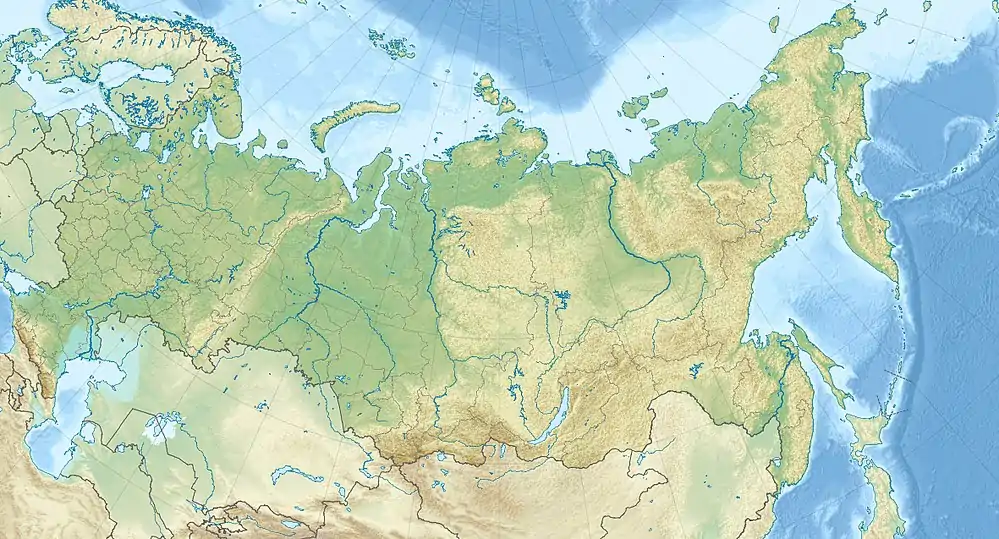Baikal Deep Underwater Neutrino Telescope
The Baikal Deep Underwater Neutrino Telescope (BDUNT) (Russian: Байкальский подводный нейтринный телескоп) is a neutrino detector conducting research below the surface of Lake Baikal (Russia) since 2003.[1] The first detector was started in 1990 and completed in 1998. It was upgraded in 2005 and again starting in 2015 to build the Baikal Gigaton Volume Detector (Baikal-GVD.)[2] BDUNT has studied neutrinos coming through the Earth with results on atmospheric muon flux. BDUNT picks up many atmospheric neutrinos created by cosmic rays interacting with the atmosphere – as opposed to cosmic neutrinos which give clues to cosmic events and are therefore of greater interest to physicists.
| Alternative names | BDUNT | ||
|---|---|---|---|
| Organization | Joint Institute for Nuclear Research, Russian Academy of Sciences | ||
| Location | Lake Baikal | ||
| Coordinates | 51°46′17″N 104°23′52″E | ||
| Established | 1990 | ||
| Website | baikalgvd | ||
| Telescopes | |||
| |||
 Location of Baikal Deep Underwater Neutrino Telescope | |||
Detector history
The start of the Baikal neutrino experiment dates back to 1 October 1980, when a laboratory of high-energy neutrino astrophysics was established at the Institute for Nuclear Research of the former Academy of Sciences of the USSR in Moscow. This laboratory would become the core of the Baikal collaboration.
The original NT-200 design was deployed in stages 3.6 km from shore at a depth of 1.1 km.
The first part, NT-36 with 36 optical modules (OMs) at 3 short strings, was put into operation and took data up to March 1995.[3] NT-72 ran 1995–1996 then was replaced by the four-string NT-96 array.[4] Over its 700 days of operation, 320,000,000 muon events were collected with NT-36, NT-72, and NT-96. Beginning April 1997, NT-144, a six-string array took data. The full NT-200 array with 192 modules was completed April 1998.[5] In 2004–2005 it was updated to NT-200+ with three additional strings around NT-200 at distance of 100 meters, each with 12 modules.[6][7]
Baikal-GVD
Since 2015, a 1 cubic km telescope, NT-1000 or Baikal-GVD (or just GVD, Gigaton Volume Detector), is being built.[8] The first stage of 3 strings was switched on in April 2013.[9][2] During 2015 the GVD demonstration cluster with 192 optical modules was successfully operated. In 2016 this array was upgraded to the baseline configuration with 288 OMs on eight vertical strings.[10] It is expected to be completed around 2020.
As of 2018, the Baikal telescope is operating.[11]
Results
BDUNT has used its neutrino detector to study astrophysical phenomena. Searches for relic dark matter in the Sun[12] and high-energy muons[13] and neutrinos[14] have been published.
See also
References
- "Icy life working with Russia's underwater 'cosmic eye'". BBC News. 24 September 2010. Retrieved 18 February 2011.
- "A new neutrino telescope for Lake Baikal – CERN Courier".
- Belolaptikov, I. A. (1995). "Results from the Baikal Underwater Telescope" (PDF). Nuclear Physics B: Proceedings Supplements. 43 (1–3): 241–244. Bibcode:1995NuPhS..43..241B. doi:10.1016/0920-5632(95)00481-N.
- Belolaptikov, I. A.; et al. (1997). "The Baikal underwater neutrino telescope: Design, performance, and first results". Astroparticle Physics. 7 (3): 263–282. Bibcode:1997APh.....7..263B. doi:10.1016/S0927-6505(97)00022-4.
- "Baikal Lake Neutrino Telescope". Baikalweb. 6 January 2005. Archived from the original on 31 August 2010. Retrieved 30 July 2008.
- Aynutdinov, V.; et al. (2005). "The Baikal neutrino experiment: From NT200 to NT200+". Proceedings of the 29th International Cosmic Ray Conference. 5: 75. Bibcode:2005ICRC....5...75A.
- Wischnewski, R.; et al. (Baikal Collaboration) (2005). "The Baikal Neutrino Telescope – Results and Plans". International Journal of Modern Physics A. 20 (29): 6932–6936. arXiv:astro-ph/0507698. Bibcode:2005IJMPA..20.6932W. doi:10.1142/S0217751X0503051X.
- Avrorin, A. V.; et al. (2011). "An Experimental String of the NT1000 Baikal Neutrino Telescope" (PDF). Instruments and Experimental Techniques. 54 (5): 649–659. doi:10.1134/S0020441211040178.
- Avrorin, A. V.; et al. (2014). "Data acquisition system of the NT1000 Baikal neutrino telescope". Instruments and Experimental Techniques. 57 (3): 262–273. doi:10.1134/S002044121403004X.
- Avrorin, A.D.; et al. (2017). "Baikal-GVD". EPJ Web of Conferences. 136: 04007. Bibcode:2017EPJWC.13604007A. doi:10.1051/epjconf/201713604007.
- https://fskbhe1.puk.ac.za/people/mboett/SAGAMMA/HEASA2018/presentations/Kouchner.pdf
- Avrorin, A.D.; et al. (2015). "Search for neutrino emission from relic dark matter in the Sun with the Baikal NT200 detector". Astroparticle Physics. 62: 12–20. arXiv:1405.3551. Bibcode:2015APh....62...12A. doi:10.1016/j.astropartphys.2014.07.006.
- Wischnewski, R.; et al. (2005). "The Baikal Neutrino Telescope – Results and Plans". International Journal of Modern Physics A. 20 (29): 6932–6936. arXiv:astro-ph/0507698. Bibcode:2005IJMPA..20.6932W. doi:10.1142/S0217751X0503051X.
- Aynutdinov, V.; et al. (BAIKAL Collaboration) (2006). "Search for a Diffuse Flux of High-Energy Extraterrestrial Neutrinos with the NT200 Neutrino Telescope". Astroparticle Physics. 25 (2): 140–150. arXiv:astro-ph/0508675. Bibcode:2006APh....25..140A. doi:10.1016/j.astropartphys.2005.12.005.